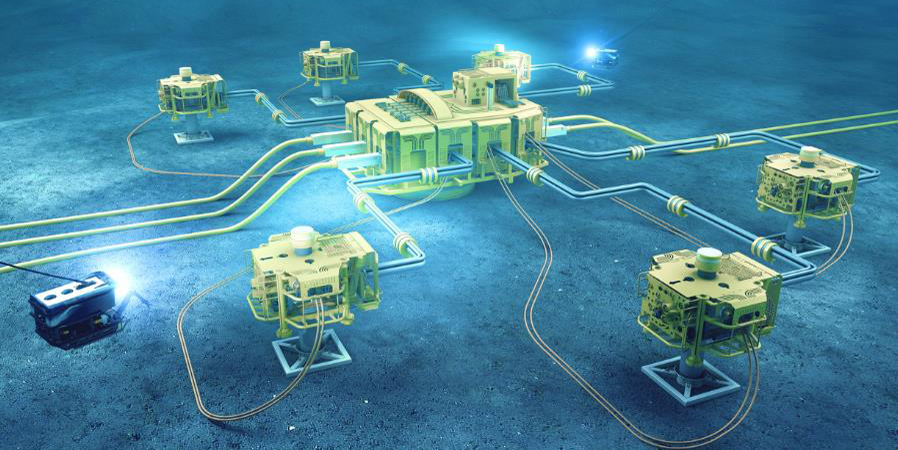
在海底传感器使用的数量和容量增长的同时,通过这些传感器传输的数据流量也在持续增加。数据传输的常规方法包括了电力调制解调器、电子DSL,电子CAN总线,电子以太网和光以太网。电力调制解调器能够在远距离传输数据,是目前海底数据传输使用的最成熟的技术。然而,该技术的数据传输上限仅为20kbps,不能满足高速传输要求,这对该技术的应用造成了极大的限制。
电子DSL在相当长一段距离内能够提供比调制解调器更高的带宽,但是可用带宽却随传输距离的增加而减少,不能为数据量丰富的技术提供足够的带宽(200-3000kb/秒,最多15公里)。电子以太网已被证明是可靠、并拥有足够带宽的数据传输技术,已大量用于石油天然气市场的短距离海底传输应用中,但该技术主要受限于传输距离较短。
为了满足不断增长的海底数据传输需求,科研人员一直在新技术的研发中进行着不断尝试,最近,两种新的技术概念逐渐脱颖而出,展现出了极强的竞争力。其中之一是在海底飞线接头研发上取得的进步,新型的接头能够满足在海底工作和数据传输带宽要求;第二,提高海底传输飞线的可靠性,在满足海底硬件标准件条件下为其添加更多功能。石油圈原创www.oilsns.com
光电复合飞线(EOFL)技术石油圈原创www.oilsns.com
一直以来,海底设备用飞线都被认为是海底基础设施中的一个被动元素,即只是作为电力和数据的传输介质。近日,Teledyne Oil & Gas成功对海底用飞线进行了升级,将传统的只能被动发挥传输作用的飞线转变为能够利用跨接器将电子产品与连接器/网络集合在一起的新产品—光电复合飞线(EOFL)。通过技术升级,飞线不再是被动传输工具,能在海底传输中发挥更重要的作用。
光电复合飞线(EOFL)具有诸多技术创新点,比如飞线的一端为Nautilus RS混合接头,另一端为7/12通道的Nautilus接头;集成电子/光学转化器位于液压平衡的油管内;电子光学元件使用承压上线为1ATM的外壳保护,一端由玻璃-金属接头保护,另一端由密封光纤接头保护。
标准的飞线接头大多采用抛光面对接(UPC)设计,在有大于30dB的信号通过时会存在一定损耗。EOFL采用了抛光面角度对接技术(APC),减少了信号损耗,已成功应用于RS和NRH联结。
与传统飞线的双绞线结构不同,EOFL只采用单根光纤进行传输。该设备将电子信号转化为光纤信号,适用于海底控制模块、数据传输系统、脐带终端、电气接线盒以及其他海底设施,目前能允许高达100Mb/秒的数据速度。如有需要,EOFL还能在四对双绞线上以1GB/秒的速度运行。
EOFL的设计中有一个功率转换器,适用范围更广,能够在不需要重新设计的前提下即可在不同的输入功率条件下工作,增加了项目要求的灵活性,减少了开发时间和成本。配备有小型收发器的EOFL还能与多个跨接器共用。
总之,在海底传输设备的设计中引进EOFL能够实现更大的领域架构灵活性,并同时为系统增加更多传输空间,提高可靠性,降低成本。石油圈原创www.oilsns.com
特性与优势石油圈原创www.oilsns.com
- 最大化光电信号转化效率;
- 承受的最高压力:4000m(6000psi),3000 m (10000 psi);
- 使用寿命为三十年(假设工作温度为4摄氏度时);
- 电源要求:24伏直流电源;
- 长度上限为300米;
- 适用温度:海水—23华氏度至104华氏度;空气—零下4华氏度至122华氏度。
如需获取关于该技术的更多资料,请联系石油圈技术小编惊蛰,QQ 2582825239。
来自/Teledyne Oil & Gas 译者/王苏涵 编辑/Lemon Zhang
Traditionally, flying leads have been considered a passive element in subsea infrastructure, meaning that power and data move through the system without interference or modification. Teledyne Oil & Gas has developed a technology platform to evolve the role of the flying lead. The Active Flying Lead product family will allow for the use of electronics integrated into a connector or in- line with the jumper, transforming the Flying Lead into an active component in a subsea data transmission system.
The Electrical Optical Flying Lead (EOFL), the newest entrant to the Active Flying Lead product line, features a Nautilus Rolling Seal Hybrid connector on one side, and a 7- or 12 –way Nautilus electrical connector on the other, with a qualified integrated electrical/optical converter within the pressure balanced, oil-filled hose (PBOF). The electro- optical components are housed in a 1 ATM enclosure and protected on one side by glass to metal seal penetrators, and a hermetic fiber penetrator on the other.
Suited for connectivity on subsea control modules, data transmission systems, umbilical terminations, electrical junction boxes and other subsea structures, the EOFL converts an electrical signal to a fiber optic signal, currently allowing up to 100 Mbit/sec data speed over 2 twisted pairs to be converted to one single fiber. The EOFL will be able to run 1 Gigabit/sec over 4 twisted pairs if needed.
The EOFL is designed with a modular power converter, which allows for different power inputs to be used without redesign, increasing flexibility in project requirements and reducing development time and costs. The use of Small Form-factor Pluggable transceivers (SFP’s) allows several jumper configurations to be possible.
Including the EOFL into the layout allows for greater field architecture flexibility, while at the same time adding redundancy to the system for increased reliability.
未经允许,不得转载本站任何文章:
-

- Demons
-
石油圈认证作者
- 毕业于中国石油大学(北京),化学工程与技术硕士,长期聚焦国内外石油行业前沿技术装备信息,具有数十万字技术文献翻译经验。如需获取更多技术资料,请联系Demons(QQ2582825239;微信15810965891)


 石油圈
石油圈
